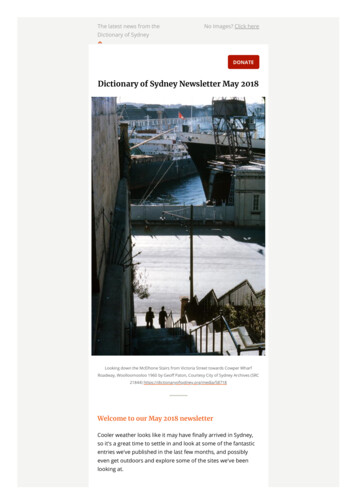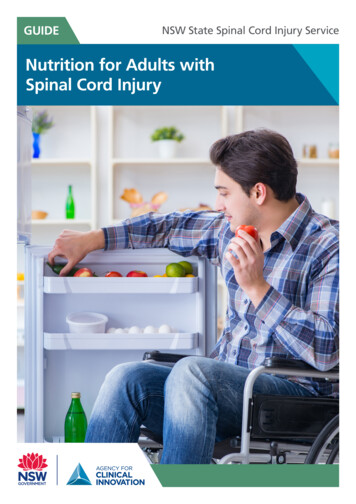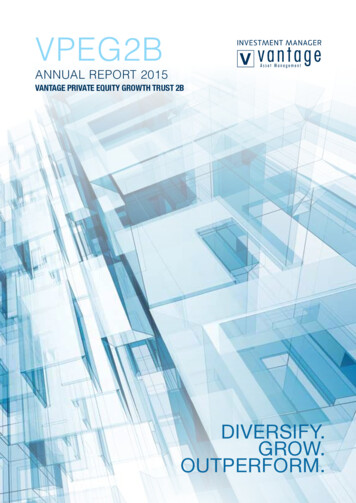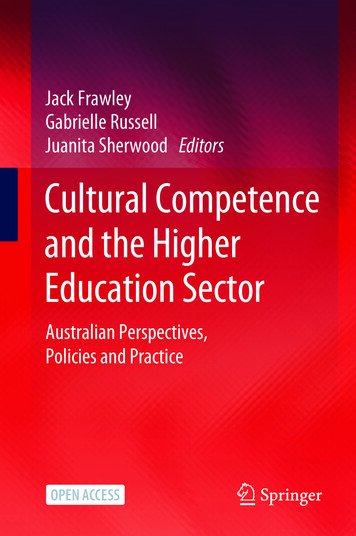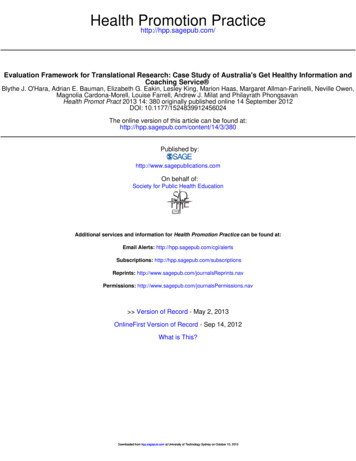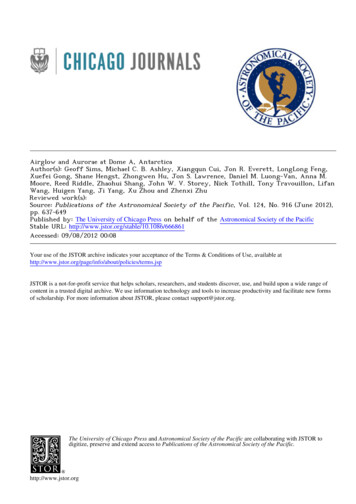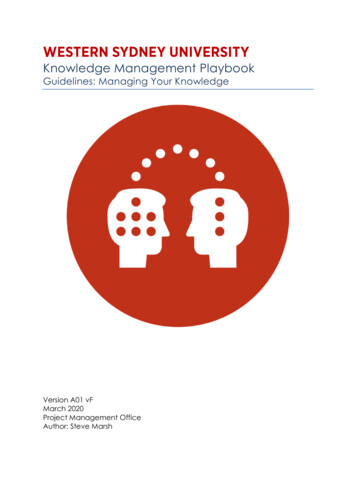
Transcription
Knowledge Management PlaybookGuidelines: Managing Your KnowledgeVersion A01 vFMarch 2020Project Management OfficeAuthor: Steve Marsh
A01 – Guidelines: Managing Your KnowledgeContentsTHE BASICS . 3Introduction . 3Why is managing our knowledge important? . 3What are our objectives in managing knowledge? . 3Definitions . 4Knowledge management lifecycle . 5GUIDELINES. 6How to manage your knowledge . 7WHY MANAGE YOUR KNOWLEDGE . 7ESTABLISHING KNOWLEDGE CATEGORIES . 8DRAFTING – Knowledge Articles . 8REVIEWING AND APPROVING – Knowledge Articles . 9PUBLISHING – Knowledge Articles . 9UPLOADING YOUR ARTICLE AND ONGOING ADMINISTRATION IN SERVICENOW . 9Knowledge Management Process Overview . 10Roles and Responsibilities (excludes any Service Now roles and responsibilities) . 11Managing Your Knowledge . 122
A01 – Guidelines: Managing Your KnowledgeTHE BASICSIntroductionThe Knowledge Management playbook provides information andexplanation of how you can use Knowledge Management processes tomanage your knowledge efficiently and within the ServiceNow platform.This playbook outlines the way Western Sydney University expects knowledgeis to be created. This playbook provides advice up to the point of uploadingyour knowledge into the ServiceNow platform. Advice on managing yourknowledge in ServiceNow is provided separately. Refer to your KnowledgeChampion for advice.Why is managing our knowledge important?Staff and students seeking services often don’t know ‘the who, what, how,and when to do’ something. Providing accurate, simple, concise and wellwritten information in the form of knowledge articles can support staffmembers or students seeking services to be able to quickly understandactions and steps they need to take and discover information to support andaid understanding.Well written knowledge articles, create increased consistency in support you,your team, or business area provide, increase visibility of knowledge to teammembers, build clearer understanding of ownership of processes, and buildcollaboration across teams, business units, and with staff and students, usingservices when change is needed.What are our objectives in managing knowledge?1. Be efficient in providing knowledge to our staff and students, and in theway we manage and administer our knowledge2. Continually improve the quality of service3. Increase staff and student satisfaction3
A01 – Guidelines: Managing Your KnowledgeDefinitionsKnowledge Management - “is a business process that formalises themanagement and use of an enterprise’s intellectual assets. KnowledgeManagement promotes a collaborative and integrative approach to thecreation, capture, organisation, access and use of information assets,including the tacit (inferred/silent), uncaptured knowledge of people.” GartnerTacit knowledge is knowledge that's difficult to write down, visualize ortransfer from one person to anotherThe goal of knowledge management is to gather, analyse, store, and shareacross the organisation.Knowledge base“A knowledge base contains knowledge categories and articles that provideusers with information such as self-help, troubleshooting, and task resolution.”Knowledge category“A knowledge category is a way to define a knowledge base. It is like thechapters in a book providing a specific place where related knowledgearticles sit.”Knowledge article “is a common document to show and explain howsomething can be done. A knowledge article would be established within aknowledge category.”Procedural knowledge articles “are step by step instructions on ‘how to’, or‘action to be taken’, or steps to followInformational knowledge articles “provides general information about atopic or subject”Note some articles may include a combination of informational content andprocedural steps (e.g. what is annual leave (information) followed by how tosubmit an application for annual leave (procedures)).4
A01 – Guidelines: Managing Your KnowledgeKnowledge management lifecycleEssentially the knowledge management lifecycle consists of 4 basic stepsDraftReviewPublishRetire5Create an article to solve the problem/answer thequestion or provide information using templates andforms to write articles that create consistency andease of understanding for staff and studentsEnsure the content is valid and that the qualitystandards are respected and maintainedMake articles available to the staff and students,providing a mechanism for feedback on qualityand accuracy of the articleRegular review and feedback of articles ensuresarticles support problem solving, provides anopportunity to update or retire redundant articlesTo understand how to create knowledge articlesand manage your knowledge refer to DocumentB01 – Guidelines: Creating Knowledge Articles
A01 – Guidelines: Managing Your KnowledgeGUIDELINESHow to use this Playbook. This graphic shows you the documents forming theframework for the Knowledge Management Playbook.6
A01 – Guidelines: Managing Your KnowledgeHow to manage your knowledgeThis section is designed to provide, guidance to assist you in managing yourknowledge.These guidelines covers1. Why manage your knowledge2. Establishing knowledge categories3. Process steps to follow ina. draftingb. reviewingc. approvingd. publishing ande. retiring knowledge articles4. TemplatesWHY MANAGE YOUR KNOWLEDGEAs staff and student need for knowledge grows, capturing and managing itin a singular structured way is becoming increasingly important. Wellmanaged knowledge requires less effort to maintain, improves accuracy,and reduces the amount of time spent responding to repetitive questions.Effective knowledge management assists staff and students obtaininformation quickly and more timely, improves decision making, and reducesthe possibility of ‘lost organisational knowledge’. Its not in someone’s head!7
A01 – Guidelines: Managing Your KnowledgeESTABLISHING KNOWLEDGE CATEGORIESIn developing your knowledge articles you will need to determine where andhow they will be stored and importantly how they can be searched andaccessed by staff and students. You should develop a hierarchy based onthe following principles1. Knowledge Base2. Knowledge Category(ies)3. Knowledge Article(s)Creating a hierarchy using these principles will assist you when you establishyour knowledge in ServiceNow .The Knowledge base should be determined by your business unit sponsor andis where all your knowledge will be maintained. Knowledge categories shouldbe determined by the Knowledge Champion(s) and are the sections whereyou will store your knowledge articles.Example1. Knowledge Base - Human Resources2. Knowledge Category(ies) – Leave3. Knowledge Article(s) – How do I apply for annual leaveDRAFTING – Knowledge ArticlesDrafting of a knowledge article is the responsibility of the knowledgedeveloper. A knowledge developer is usually a team member who is asubject matter expert (SME) in the area of knowledge to be developed.There may be several subject matter experts within the team, and they maycollaborate in developing a knowledge article for review. Reviewing of yourKnowledge Article is undertaken by your Knowledge Champion. To draft aknowledge article Refer to Documents B01 Creating a Knowledge Article andB02 Knowledge Article Template8
A01 – Guidelines: Managing Your KnowledgeREVIEWING AND APPROVING – Knowledge ArticlesThis section will help you in reviewing NEW knowledge articles for approvalprior to publishing in Service Now. This section do not reference managingexisting knowledge bases, categories or articles, held in other documents orsystems.Following drafting of your knowledge article, your article should be submittedto your Knowledge Champion for review.The Knowledge Champion coordinates day-to-day knowledge managementprocess activities in your area. One of the tasks for the Knowledge Championis to review your submitted knowledge articles to ensure the content is validand that your business unit’s quality standards are met. If required, they mayseek additional information from you and may request the article beamended prior to approval.Once your article has been reviewed and deemed ready your KnowledgeChampion will approve your article for publication. Refer to C01 KnowledgeArticle Register.Following approval the article can be published on ServiceNow .PUBLISHING – Knowledge ArticlesTo publish your knowledge article you will require training in Service Now.Please contact your Knowledge Champion to arrange this training.UPLOADING YOUR ARTICLE AND ONGOING ADMINISTRATION INSERVICENOW Training in managing knowledge within the ServiceNow platform isavailable and must be completed. Please contact your KnowledgeChampion to arrange this training.9
A01 – Guidelines: Managing Your KnowledgeKnowledge Management Process OverviewKNOWLEDGE MANAGEMENT PROCESS TO CREATE AND MANAGE A KNOWLEDGE ARTICLE V1.0REVIEW/APPROVEOther Processes10PUBLISHRETIRERequest new knowledgearticle/update an existingarticleReview knowledge articledue for retirementCreate update and submitarticle for approvalKnowledge ChampionKnowledge DeveloperKnowledge UserDRAFTReview & Approveknowledge gementService PortalIncidentManagementCaseManagementPublish knowledge articleServicecNowKnowledgeManagement DatabaseServicePortalApprove and retireknowledge article
A01 – Guidelines: Managing Your KnowledgeRoles and Responsibilities (excludes any Service Now roles andresponsibilities)RoleKnowledgeUserKnowledge users are the staff andstudents who use knowledgearticles.KnowledgeDeveloperResponsibility Review and use knowledge inday-to-day activities Identifyanymissingknowledge required for dayto-day activities Identifyknowledgethatneeds to be updated Create Knowledge articles ledge developers are thosewho create and edit knowledgearticles to share information acrossthe organisation. Are often knownas subject matter experts (SME)The knowledge champion assigns KnowledgeDevelopers,andsupports the daily administration ofknowledge, including review andapproval steps prior to publishing. They define knowledge categorystructures, where articles will sit.KnowledgeChampion Sponsor11oThe sponsor is the organisations advocate and lead. They serve asthe voice for organisation. Theygathers the appropriate supportand resources ensuring buy-in. Manage and coordinate allof the day-to-day knowledgemanagementprocessactivitiesDefine knowledge categoriesReview submitted knowledgearticles to ensure the contentis valid and that the qualitystandards are respectedObtaintheappropriatesubject matter expert (SME)validation when neededIdentify need for new contentApprove knowledge articlesfor publication in Service NowEncouragepeopletocontribute knowledge articlesProvide leadership in themanagement and delivery ofthe business unit’s servicesincluding knowledgeDetermine the Knowledgebase
A01 – Guidelines: Managing Your KnowledgeManaging Your KnowledgeTemplates to useKnowledge Article RegisterRefer to C01 Knowledge Article Register.This template is to be used to track and monitor the development ofknowledge articlesRoles and Responsibility TemplateRefer to C02 Individual and Team Responsibility RegisterThis template is to be used to identify the roles and responsibilities within abusiness unit responsible for all aspects of knowledge management withintheir unit.12
Gartner Tacit knowledge is knowledge that's difficult to write down, visualize or transfer from one person to another The goal of knowledge management is to gather, analyse, store, and share across the organisation. Knowledge base "A knowledge base contains knowledge categories and articles that provide


